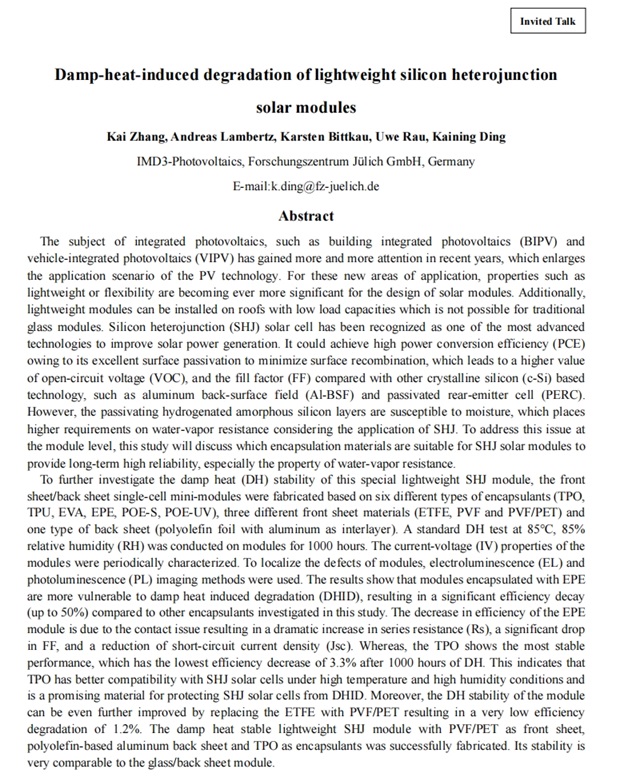| Damp-heat-induced degradation of lightweight silicon heterojunction solar modules 【Kaining Ding】 |
| 发布时间:2024-09-26 | 浏览次数:146 |
Damp-heat-induced degradation of lightweight silicon heterojunction solar modules Kai Zhang, Andreas Lambertz, Karsten Bittkau, Uwe Rau, Kaining Ding IMD3-Photovoltaics, Forschungszentrum Jülich GmbH, Germany E-mail:k.ding@fz-juelich.de Abstract The subject of integrated photovoltaics, such as building integrated photovoltaics (BIPV) and vehicle-integrated photovoltaics (VIPV) has gained more and more attention in recent years, which enlarges the application scenario of the PV technology. For these new areas of application, properties such as lightweight or flexibility are becoming ever more significant for the design of solar modules. Additionally, lightweight modules can be installed on roofs with low load capacities which is not possible for traditional glass modules. Silicon heterojunction (SHJ) solar cell has been recognized as one of the most advanced technologies to improve solar power generation. It could achieve high power conversion efficiency (PCE) owing to its excellent surface passivation to minimize surface recombination, which leads to a higher value of open-circuit voltage (VOC), and the fill factor (FF) compared with other crystalline silicon (c-Si) based technology, such as aluminum back-surface field (Al-BSF) and passivated rear-emitter cell (PERC). However, the passivating hydrogenated amorphous silicon layers are susceptible to moisture, which places higher requirements on water-vapor resistance considering the application of SHJ. To address this issue at the module level, this study will discuss which encapsulation materials are suitable for SHJ solar modules to provide long-term high reliability, especially the property of water-vapor resistance. To further investigate the damp heat (DH) stability of this special lightweight SHJ module, the front sheet/back sheet single-cell mini-modules were fabricated based on six different types of encapsulants (TPO, TPU, EVA, EPE, POE-S, POE-UV), three different front sheet materials (ETFE, PVF and PVF/PET) and one type of back sheet (polyolefin foil with aluminum as interlayer). A standard DH test at 85℃, 85% relative humidity (RH) was conducted on modules for 1000 hours. The current-voltage (IV) properties of the modules were periodically characterized. To localize the defects of modules, electroluminescence (EL) and photoluminescence (PL) imaging methods were used. The results show that modules encapsulated with EPE are more vulnerable to damp heat induced degradation (DHID), resulting in a significant efficiency decay (up to 50%) compared to other encapsulants investigated in this study. The decrease in efficiency of the EPE module is due to the contact issue resulting in a dramatic increase in series resistance (Rs), a significant drop in FF, and a reduction of short-circuit current density (Jsc). Whereas, the TPO shows the most stable performance, which has the lowest efficiency decrease of 3.3% after 1000 hours of DH. This indicates that TPO has better compatibility with SHJ solar cells under high temperature and high humidity conditions and is a promising material for protecting SHJ solar cells from DHID. Moreover, the DH stability of the module can be even further improved by replacing the ETFE with PVF/PET resulting in a very low efficiency degradation of 1.2%. The damp heat stable lightweight SHJ module with PVF/PET as front sheet, polyolefin-based aluminum back sheet and TPO as encapsulants was successfully fabricated. Its stability is very comparable to the glass/back sheet module.
|






